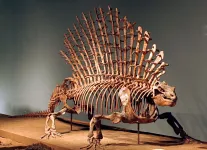(Press-News.org) NEW YORK, NY--March 2, 2021--In March and April 2020, mental health claim lines for individuals aged 13-18, as a percentage of all medical claim lines, approximately doubled over the same months in the previous year. At the height of the spring wave of the COVID-19 pandemic, this rise in mental health claim lines amounted to 97.0 percent in March and 103.5 percent in April. These are among the many findings in FAIR Health's new white paper, the seventh in its COVID-19 studies, The Impact of COVID-19 on Pediatric Mental Health: A Study of Private Healthcare Claims.
In those same months of March and April 2020, all medical claim lines (including mental health claim lines) decreased by approximately half (53.3 percent in March 2020 and 53.4 percent in April 2020), FAIR Health found. That pattern of increased mental health claim lines and decreased medical claim lines continued through November 2020, though to a lesser extent.
Defining the pediatric population as individuals aged 0-22 years, and focusing on the age groups 13-18 years and 19-22 years, FAIR Health studied the effects of the COVID-19 pandemic on US pediatric mental health. To do so, FAIR Health analyzed data from its database of over 32 billion private healthcare claim records, tracking month-by-month changes from January to November 2020 compared to the same months in 2019. Aspects of pediatric mental health investigated include overall mental health, intentional self-harm, overdoses and substance use disorders, top mental health diagnoses, reasons for emergency room visits and state-by-state variations.
The decrease in all medical claim lines is likely due to widespread restrictions on nonemergency medical care in spring 2020 and continuing avoidance of such care even after restrictions were lifted in May. It is striking, therefore, that one component of medical care, mental healthcare, increased significantly even while overall medical care was falling.
Other findings reported in the white paper include:
Comparing August 2019 to August 2020 in the Northeast, for the age group 13-18, there was a 333.93 percent increase in intentional self-harm claim lines as a percentage of all medical claim lines, a rate higher than that in any other region in any month studied for that age group.
Claim lines for intentional self-harm as a percentage of all medical claim lines in the 13-18 age group increased 90.71 percent in March 2020 compared to March 2019. The increase was even larger when comparing April 2020 to April 2019, nearly doubling (99.83 percent).
For the age group 13-18, claim lines for overdoses increased 94.91 percent as a percentage of all medical claim lines in March 2020 and 119.31 percent in April 2020 over the same months the year before. Claim lines for substance use disorders also increased as a percentage of all medical claim lines in March (64.64 percent) and April (62.69 percent) 2020 as compared to their corresponding months in 2019.
For the age group 6-12, from spring to November 2020, claim lines for obsessive-compulsive disorder and tic disorders increased as a percentage of all medical claim lines from their levels in the corresponding months of 2019.
For the age group 13-18, in April 2020, claim lines for generalized anxiety disorder increased 93.6 percent as a percentage of all medical claim lines over April 2019, while major depressive disorder claim lines increased 83.9 percent and adjustment disorder claim lines 89.7 percent.
In general, the age group 19-22 had mental health trends similar to but less pronounced than the age group 13-18.
FAIR Health President Robin Gelburd stated: "The COVID-19 pandemic has had a profound impact on mental health, particularly on that of young people. The findings in our new report have implications for all those responsible for the care of young people, including providers, parents, educators, policy makers and payors."
This is the seventh in a series of studies released by FAIR Health on the COVID-19 pandemic. The first study examined projected US costs for COVID-19 patients requiring inpatient stays, the second the impact of the pandemic on hospitals and health systems, the third the impact on healthcare professionals, the fourth key characteristics of COVID-19 patients, the fifth the impact on the dental industry and the sixth risk factors for COVID-19 mortality.
INFORMATION:
For the new white paper, click here.
Follow us on Twitter @FAIRHealth
About FAIR Health
FAIR Health is a national, independent nonprofit organization that qualifies as a public charity under section 501(c)(3) of the federal tax code. It is dedicated to bringing transparency to healthcare costs and health insurance information through data products, consumer resources and health systems research support. FAIR Health possesses the nation's largest collection of private healthcare claims data, which includes over 32 billion claim records and is growing at a rate of over 2 billion claim records a year. FAIR Health licenses its privately billed data and data products--including benchmark modules, data visualizations, custom analytics and market indices--to commercial insurers and self-insurers, employers, providers, hospitals and healthcare systems, government agencies, researchers and others. Certified by the Centers for Medicare & Medicaid Services (CMS) as a national Qualified Entity, FAIR Health also receives data representing the experience of all individuals enrolled in traditional Medicare Parts A, B and D; FAIR Health includes among the private claims data in its database, data on Medicare Advantage enrollees. FAIR Health can produce insightful analytic reports and data products based on combined Medicare and commercial claims data for government, providers, payors and other authorized users. FAIR Health's systems for processing and storing protected health information have earned HITRUST CSF certification and achieved AICPA SOC 2 compliance by meeting the rigorous data security requirements of these standards. As a testament to the reliability and objectivity of FAIR Health data, the data have been incorporated in statutes and regulations around the country and designated as the official, neutral data source for a variety of state health programs, including workers' compensation and personal injury protection (PIP) programs. FAIR Health data serve as an official reference point in support of certain state balance billing laws that protect consumers against bills for surprise out-of-network and emergency services. FAIR Health also uses its database to power a free consumer website available in English and Spanish and an English/Spanish mobile app, which enable consumers to estimate and plan for their healthcare expenditures and offer a rich educational platform on health insurance. The website has been honored by the White House Summit on Smart Disclosure, the Agency for Healthcare Research and Quality (AHRQ), URAC, the eHealthcare Leadership Awards, appPicker, Employee Benefit News and Kiplinger's Personal Finance. FAIR Health also is named a top resource for patients in Dr. Marty Makary's book The Price We Pay: What Broke American Health Care--and How to Fix It and Elisabeth Rosenthal's book An American Sickness: How Healthcare Became Big Business and How You Can Take It Back. For more information on FAIR Health, visit fairhealth.org.
When it comes to the evolution of the mammal spine -- think of animals whose backbone allows them to gallop, hop, swim, run, or walk upright -- a key part of the tale is quite simple.
Because nonmammalian synapsids, the extinct forerunners to mammals, had similar traits to living reptiles (like having their limbs splayed out to the side instead of tucked into their body like today's mammals), the strongheld belief was that they must have also moved in similar ways. Primarily, their backbones must have moved side-to-side, bending like those of modern lizards, instead of the up-and-down bending motion mammal spines are known for. It's believed over time, and in response to selective pressures, the mammal spine evolved from that lizard like side-to-side bending ...
UNIVERSITY PARK, Pa. -- By modeling wolves in Yellowstone National Park, researchers have discovered that how a population is organized into social groups affects the spread of infectious diseases within the population. The findings may be applicable to any social species and could be useful in the protection of endangered species that suffer from disease invasion.
Like other social carnivores, wolves tend to form territorial social groups that are often aggressive toward each other and may lead to fatalities. During these encounters, infectious diseases -- like mange and canine distemper -- can spread between groups, which can further reduce the number of individuals in a group.
"Previous social group-disease models have assumed that groups do not change ...
WESTMINSTER, Colorado - March 02, 2021 - Herbicide-resistant weeds have fueled a growing demand for effective, nonchemical weed controls. Among the techniques used are chaff carts, impact mills and other harvest-time practices that remove or destroy weed seeds instead of leaving them on the field to sprout.
A recent article in the journal Weed Science explores whether such harvest-time controls would be effective against downy brome, Italian ryegrass, feral rye and rattail fescue - weeds that compete with winter wheat in the Pacific Northwest. Researchers set out to determine whether ...
New research has found that shrimp like creatures on the South Coast of England have 70 per cent less sperm than less polluted locations elsewhere in the world. The research also discovered that individuals living in the survey area are six times less numerous per square metre than those living in cleaner waters.
This discovery, published today in Aquatic Toxicology, mirrors similar findings in other creatures, including humans. The scientist leading research at the University of Portsmouth believes pollutants might be to blame, further highlighted by this ...
Resveratrol is a plant compound found primarily in red grapes and Japanese knotweed. Its synthetic variant has been approved as a food ingredient in the EU since 2016. At least in cell-based test systems, the substance has anti-inflammatory properties. A recent collaborative study by the Leibniz Institute for Food Systems Biology at the Technical University of Munich and the Institute of Physiological Chemistry at the University of Vienna has now shown that the bitter receptor TAS2R50 is involved in this effect. The team of scientists led by Veronika Somoza ...
CHICAGO, March 2, 2021 -- More than 70 percent of dentists surveyed by the American Dental Association (ADA) Health Policy Institute are seeing an increase of patients experiencing teeth grinding and clenching, conditions often associated with stress. This is an increase from ADA data released in the fall that showed just under 60 percent of dentists had seen an increase among their patients.
"Our polling has served as a barometer for pandemic stress affecting patients and communities seen through the eyes of dentists," said Marko Vujicic, Ph.D., chief economist and vice president of the ADA Health Policy Institute. "The increase over time suggests stress-related conditions have become substantially more prevalent since the onset of COVID-19."
The ...
BOSTON - Lymph nodes in the armpit area can become swollen after a COVID-19 vaccination, and this is a normal reaction that typically goes away with time. Radiologists at Massachusetts General Hospital (MGH) who recently published an approach to managing this situation in women who receive mammograms for breast cancer screening in the American Journal of Roentgenology have now expanded their recommendations to include care for patients who undergo other imaging tests for diverse medical reasons. Their guidance is published in the Journal of the American College of Radiology.
"Our ...
A new study published today in the journal Geophysical Research Letters used NASA's ice-measuring laser satellite to identify atmospheric river storms as a key driver of increased snowfall in West Antarctica during the 2019 austral winter.
These findings from scientists at Scripps Institution of Oceanography at the University of California San Diego and colleagues will help improve overall understanding of the processes driving change in Antarctica, and lead to better predictions of sea-level rise. The study was funded by NASA, with additional support from the Rhodium Group's Climate Impact Lab, a consortium ...
CLEVELAND - Researchers from Cleveland Clinic's Global Center for Pathogen Research & Human Health have developed a promising new COVID-19 vaccine candidate that utilizes nanotechnology and has shown strong efficacy in preclinical disease models.
According to new findings published in mBio, the vaccine produced potent neutralizing antibodies among preclinical models and also prevented infection and disease symptoms in the face of exposure to SARS-CoV-2 (the virus that causes COVID-19). An additional reason for the vaccine candidate's early appeal is that it may be thermostable, which would make it easier to transport and store than currently authorized COVID-19 ...
There's more to taste than flavor. Let ice cream melt, and the next time you take it out of the freezer you'll find its texture icy instead of the smooth, creamy confection you're used to. Though its flavor hasn't changed, most people would agree the dessert is less appetizing.
UC Santa Barbara Professor Craig Montell and postdoctoral fellow Qiaoran Li have published a study in Current Biology providing the first description of how certain animals sense the texture of their food based on grittiness versus smoothness. They found that, in fruit flies, a mechanosensory channel relays this information about a food's texture.
The channel, called TMEM63, is part of ...






